I. How are the Kidney and Nephron Structured?
When taking a step back and looking at the kidneys at a grander scale, it’s amazing to think that these 2 little, bean-shaped organs are essentially responsible for a good portion of the homeostatic balance that needs to be maintained in the human body.
In regards to the microscopic structure and functioning of the nephron, it can be a little daunting because there are so many details that accompany this topic. However, in this article, we’ll spare you the really minute details of nephron structure and function and give you just what you need to know for the MCAT!
II. Gross and Microscopic Structure of the Kidney
We’ll divide our discussion of kidney structure into a gross anatomy covering and an in depth review of the nephron — hopefully after reviewing both, we can piece the whole thing together and understand how the tiny intricacies of the nephron eventually correlate to the kidney on a macroscale!
A. Gross Anatomy
As mentioned, the kidney is a bean-shaped organ which primarily functions to filter out blood and form urine. Shown on the left side towards the middle is an opening into the kidney called the renal hilum which is where the renal artery enters and the renal vein and ureter exit!
The inside of the kidney houses the renal cortex and medulla — it’s at the junction of the renal cortex and medulla where the nephrons are located and allow for blood filtration and urine formation.
The formed urine is collected in the renal pyramids which then further accumulates at the renal pelvis. Finally, urine from the renal pelvis enters the ureter which is eliminated via the urinary system!
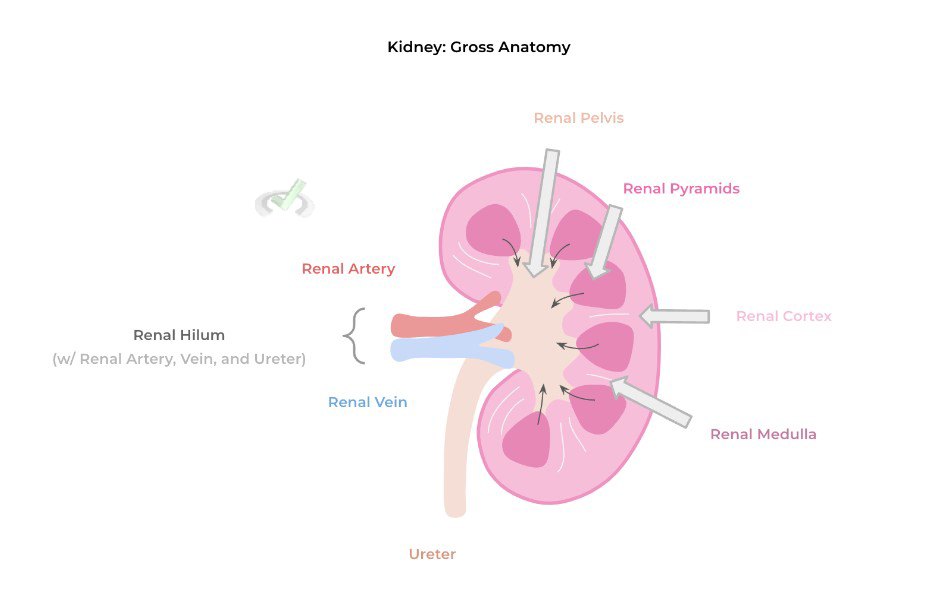
B. Nephron Structure
The best way to think of the nephron is similar to what an osteon is for bone tissue, the fundamental structural and functional unit of the kidney — it's at this microscopic structure where the processes of glomerular filtration, tubular secretion and reabsorption come together!
There are 5 main components of the nephron: the glomerulus, proximal convoluted tubule (PCT), the loop of Henle (with descending and ascending limbs), distal convoluted tubule (DCT) and collecting duct.
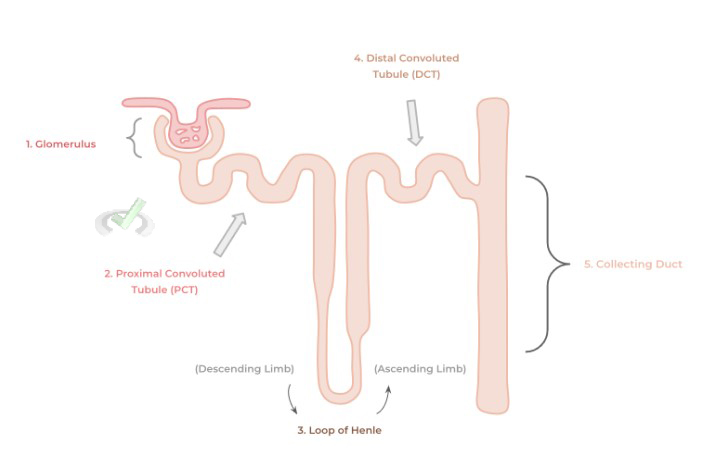
Though not shown, recall that the efferent renal arteriole continues its pathway from the glomerulus running adjacent to the remaining tubular structures of the nephron forming peritubular capillaries: these are the blood vessels which interact with the nephron to allow for secretion and reabsorption.
I. Glomerulus
The blood entering into the nephron comes from a renal afferent arteriole and eventually makes its way into a specialized capillary structure called the renal glomeruli which is housed in a cup-lack sac called Bowman’s capsule.
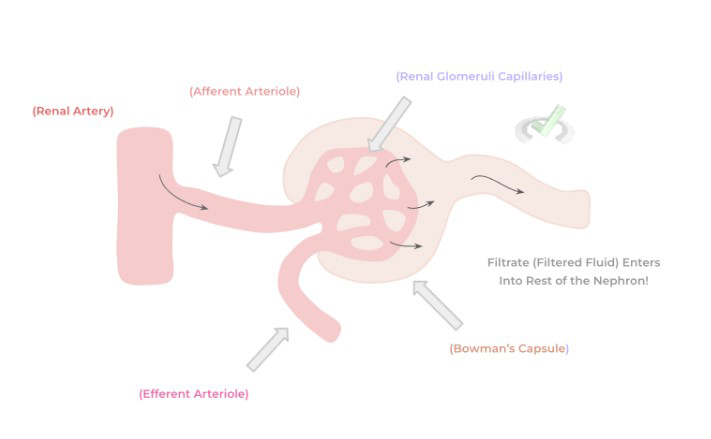
These capillaries are unique in the sense that they’re fenestrated (“having holes”) to allow for blood filtration — these holes ensure that no critical cells and proteins from the blood enter the filtrate which continues into the nephron and eventually forms urine!
In addition, associated with the capillaries are cells called podocytes which also aid in blood filtration as they have cellular, foot-like extensions which interact with the capillaries and further act as a sift to filter out blood and form filtrate!
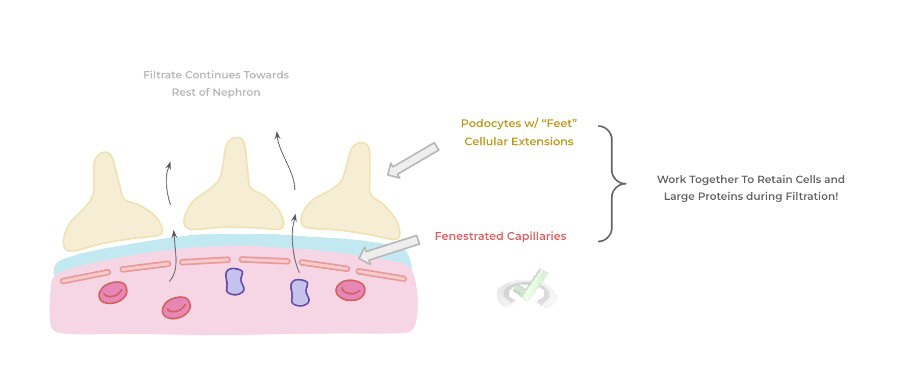
II. Proximal Convoluted Tubule (PCT)
The next stop for the filtrate after the glomerulus is the proximal convoluted tubule which — as the name suggests — as a convoluted, twisty shape to the tubule.
It’s at the PCT where a majority of essential nutrients are reabsorbed back into the bloodstream including basically 100% of the glucose and amino acids in the filtrate, as well as some electrolytes like Na+, Cl-, and K+.
In addition about, 65% of water is reabsorbed in this area as well. The PCT also secretes other unwanted substances into the filtrate including hydrogen ions, urea, and ammonia.
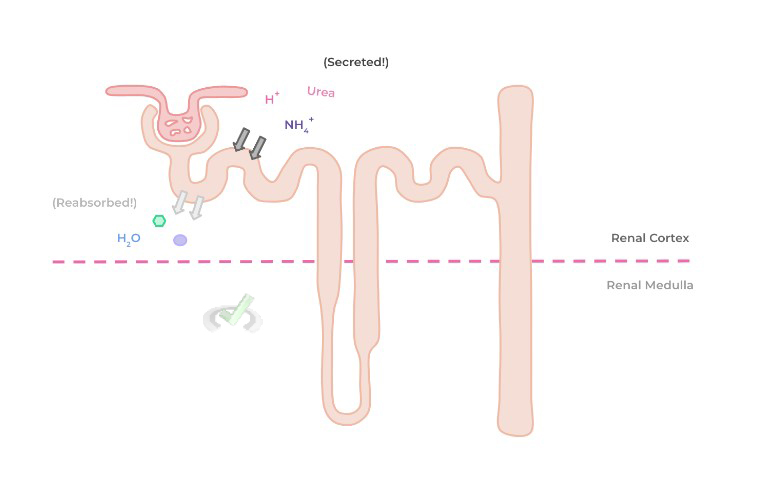
III. Loop of Henle
After the PCT, the nephron further extends down into the renal medulla and becomes a structure called the loop of Henle!
Technically, in addition to the loop, there are also 2 limbs that make up this nephron structure: the descending limb which precedes the loop and extends from the PCT and an ascending limb which comes after loop and extends into the DCT!
At the descending limb — to be specific, the thin, descending limb, water is also reabsorbed in a passive process! Conversely, the main event that occurs in the ascending limb is the reabsorption of Na⁺ and Cl⁻ ; however, this is accomplished via active transport! Note also that the ascending limb is impermeable to water due to a lack of aquaporin expression.
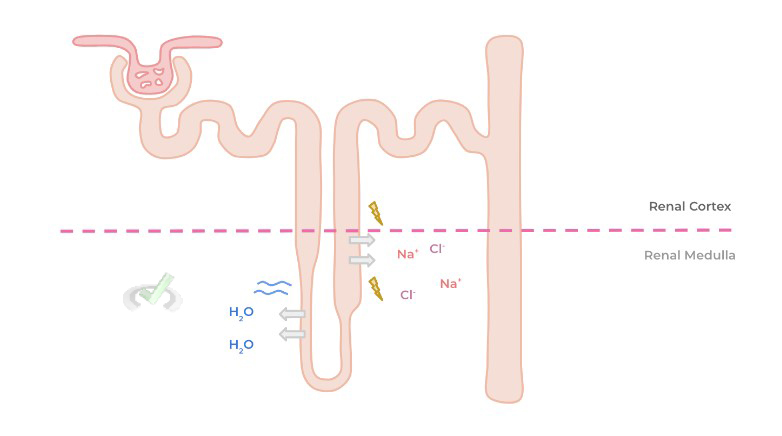
IV. Distal Convoluted Tubule (DCT)
Continuing from the loop of Henle — specifically the ascending limb — the nephron extends as another twisty, tubular structure called the distal convoluted tubule. This nephron structure is highly important due to its interaction with many endocrine hormones!
One of these hormones is aldosterone which is released upon activation of the RAAS system. The binding of aldosterone to receptors in the DCT stimulates Na⁺ reabsorption which allows for water reabsorption via osmosis, allowing for increased blood volume and pressure!
In addition, the hormone vasopressin also works at this site to increase water reabsorption to increase blood volume and pressure! It accomplishes this by the expression of aquaporins which allow for the reabsorption of water molecules!
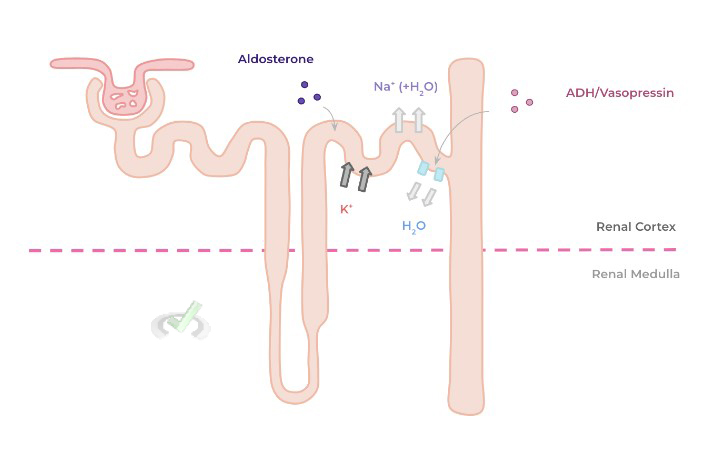
Another aspect to note is that aldosterone stimulates the secretion of K⁺ — the reason potassium secretion doesn’t counteract the water osmosis that occurs due to sodium reabsorption is because the serum concentration of Na+ is much larger than K+.
To give some numbers to get a better context, the average sodium serum concentration 135 - 145 mmol/L while the average potassium serum concentration 3.6 - 5.5 mmol/L.
V. Collecting Duct
The last portion of the nephron is the collecting duct which is also the last part where the filtrate can be concentrated. This is because water reabsorption also occurs here via the action of vasopressin!
Just like in the distal convoluted tubule, vasopressin binds to receptors at the collecting duct and initiates the expression of aquaporins to allow for water reabsorption!
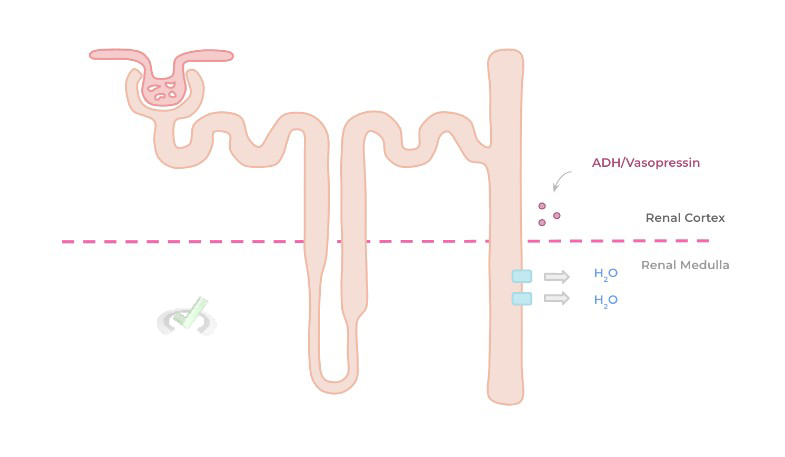
Finally, let’s try to connect the structures from a microscopic scale to the gross anatomy! The collecting duct resides in the renal papilla and allows for the excretion of the urine into the renal pelvis!
Urine then collects in the renal pelvis which is funneled down the ureter in order to be excreted via the urinary system!
III. Bridge/Overlap
Earlier, we touched upon how the descending and ascending limb of the loop of Henle allowed for both water and salt reabsorption via passive and active transport, respectively. Let’s go ahead and do a quick review of what these terms mean and how they differ from one another!
I. Passive v.s. Active Transport
As the name implies, a molecule moving via passive transport should not have any expenditure of energy due to the fact that the molecule of interest is moving DOWN its concentration gradient. Recall that this is seen in the case for the thin descending limb’s reabsorption of water!
In contrast, active transport refers to a molecule which requires energy expenditure in order to be moved across a membrane because the molecule is moving AGAINST its concentration gradient — recall that this is seen for the active transport that is required for salt reabsorption in the thick ascending limb!
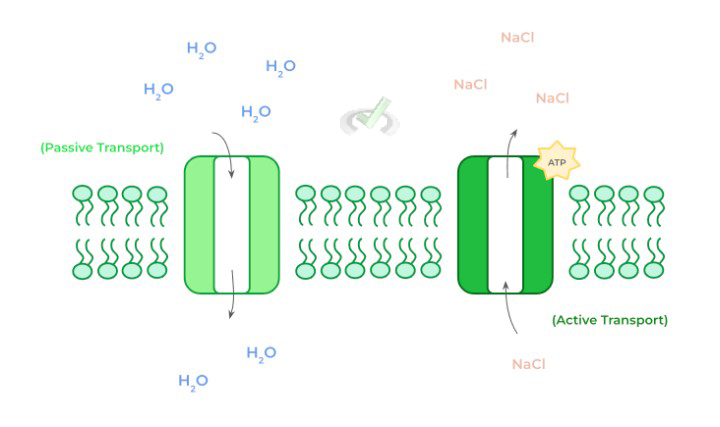
IV. Wrap Up/Key Terms
Let’s take this time to wrap up & concisely summarize what we covered above in the article!
A. Gross Anatomy
The 2 kidneys are bean shaped organs which primarily work to filter blood and excrete toxic waste products. Vessels such as the renal artery, vein, and ureter enter and exit the kidney via renal hilum.
Within the kidney resides the outer renal cortex and the inner renal medulla — the junction of the cortex and medulla contains the nephron, the structural and functional unit of the kidneys.
Within the renal medulla are the renal pyramids where urine collects initially before being dumped into the renal pelvis. Urine from the renal pelvis is then funneled down into the ureter and is eventually excreted via the urinary system.
B. Nephron Structure
As mentioned, the nephron is the structural and functional unit of the kidney where blood filtration and urine formation occurs!
There are 5 main structural components of the nephron: the glomerulus, proximal convoluted tubule (PCT), loop of Henle (with descending and ascending limb), the distal convoluted tubule (DCT), and the collecting duct.
I. Glomerulus
Blood enters into the nephron from the afferent renal arteriole into the renal glomeruli, a specialized type of capillary encapsulated by Bowman’s capsule. The capillaries have a tuft, spherical structure and are fenestrated in order to allow for blood filtration!
These capillaries also have associated podocytes, which are cells with “foot-like” cellular processes which interact with the glomeruli to further aid in filtration.
The main goal in this step is to retain cells and large proteins in the blood — the filtered fluid with all its contents forms the filtrate which continues into the PCT!
II. Proximal Convoluted Tubule (PCT)
The next structure of the nephron is the proximal convoluted tubule which reabsorbs the main macromolecules including glucose and amino acids as well as about ⅔ of the water.
The PCT also allows for the secretion of other molecules such as hydrogen ions, urea, and ammonia!
III. Loop of Henle
Extending from the proximal convoluted tubule into the renal medulla is the loop of Henle with an associating descending and ascending limb.
The descending limb is responsible for the passive reabsorption of water while the ascending limb is responsible for the reabsorption of sodium and chloride via active transport!
IV. Distal Convoluted Tubule (DCT)
Continuing from the ascending limb is the distal convoluted tubule which has many hormones acting upon it!
Aldosterone binds to receptors at this site to initiate sodium reabsorption and potassium secretion — the reabsorption of sodium also causes the reabsorption of water via osmosis.
Vasopressin also acts on the distal convoluted tubule to allow for water reabsorption via the increased expression of aquaporin proteins!
V. Collecting Duct
It’s at the collecting duct where the filtrate can become concentrated before forming urine. This is because water is also reabsorbed at the collecting duct also via the action of vasopressin!
V. Practice
Take a look at these practice questions to see and solidify your understanding!
Sample Practice Question 1
When examining the urine, a nephrologist notices that the urine has a red color possibly indicating the presence of blood. As such, which of the following nephron structures is dysfunctional and is leading to this problem?
A. Proximal Convoluted Tubule
B. Glomerulus
C. Distal Convoluted Tubule
D. Collecting Duct
Ans. B. Glomerulus
The presence of blood in the urine indicates the presence of red blood cells. Recall that the glomerulus works to filter out cells and large proteins — as such, a dysfunctional glomerulus would result in these cells and large proteins leaking into the filtrate causing the presence of blood in urine!
Sample Practice Question 2
When examining the results of a urinalysis of the patient, a nephrologist notes that the urine glucose level is 2.8 mmols/L (N: 0 -0.8 mmols/L) and the urine sodium level is 50 mEq/L (N: 40 mEq/L - 200 mEq/L). Which of the following nephron structures is likely dysfunctional?
A. Collecting Duct
B. Ascending Limb
C. Proximal Convoluted Tubule
D. Distal Convoluted Tubule
Ans. C. Proximal Convoluted Tubule
The proximal convoluted tubule is primarily responsible for the reabsorption of major macromolecules such as glucose and amino acids. If the urine glucose level is much higher than expected, then there is probably some sort of problem with the PCT in reabsorbing glucose back into the bloodstream!







 To help you achieve your goal MCAT score, we take turns hosting these
To help you achieve your goal MCAT score, we take turns hosting these 





















 reviews on TrustPilot
reviews on TrustPilot